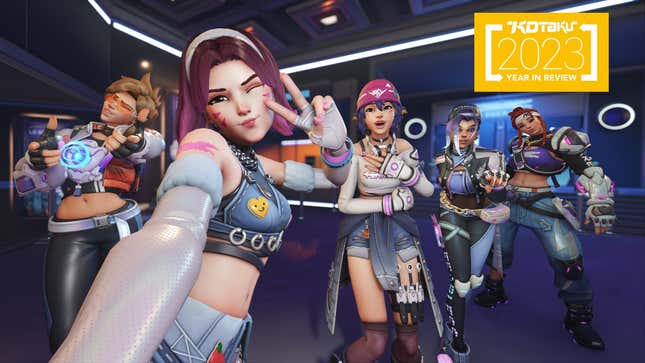
Overwatch 2 debuted in late 2022, and the controversial sequel to Blizzard’s beloved hero shooter struggled in its first few months. Messaging around it was confusing (we were meant to get a sequel that shared a multiplayer environment with the original game, instead the original game was shut down), expectations weren’t met (Overwatch 2 launched in quite a messy state), and the battle pass monetization shift frustrated long-time fans (self-explanatory). But 2023 was the first full year of Overwatch 2 support, content, and gameplay, and Blizzard has made some major strides.
At times, it felt like a two-steps-forward, one-step-back dance—we got some great crossovers, but the cosmetics were expensive, and PvE was gutted, but good, but expensive. As long-term Overwatch fans, it’s been a strange year for the hero shooter and its expanded universe, but despite its ups and downs, we remained pretty regular players. That has to say something about the game, right?
So, let’s look back at the year in Overwatch 2, from new heroes to old classics, and all the Pride parade in between.

Overwatch 2’s new modes, cosmetics, balance tweaks, and events mean nothing if the heroes aren’t compelling, fun to play, and rewarding to master. The game launched with three new heroes at the end of 2022, and it has added three new ones in the past year. Each has brought something new to the table, though Blizzard has had its hands full working to get some of them right.
Lifeweaver kicked things off in April, and was immediately panned for his low healing output and easily abused playstyle. In the months that followed, Blizzard moved some numbers around and even removed one of his passive abilities (RIP Parting Gift), and now Lifeweaver is a respectable healer with some good, if situational, utility.
Illari was next, giving Moira a run for her money as the resident “DPS support” queen. She has a high skill ceiling and requires a lot of game sense to make quick choices between healing and shooting heads, but overall she’s been a solid addition for the type of support player who wants to be active in the fight alongside their team.
Lastly, after years of waiting, Overwatch 2 fans can finally play as Mauga, Talon’s chaotic, beefy, yet somehow still easy-to-kill tank. Blizzard has recently been putting in the work to make its latest hero as strong as he looks, but his playstyle means he’s a big target without a lot of defensive capabilities. His sustainability aside, Mauga has a ton of damage output that can devastate an enemy team.
None of these heroes have set the game on fire, and I’m sure Blizzard has been doing its utmost to avoid a Brigitte situation, who infamously upended the meta and was blamed for Role Queue getting added to limit team compositions. But they’ve each carved out their own space in Overwatch 2’s roster. — Kenneth Shepard, staff writer

Two heroes saw major reworks this year: Sombra and Roadhog. Whether you think those reworks are good or not is sort of based on who you play—I’m sure Kenneth loves Sombra’s rework, which lets her teleport faster, have passive stealth, and otherwise annoy the fuck out of backline healers, but I, as a healer, hate it.
Tank Roadhog’s November rework gave the big boy a huge trap like his best friend Junkrat, which let him do some more AOE damage and changed things up from his typical, laser-focused attack approach. It also changed how he heals himself, placing the function in the secondary fire slot and giving you a meter sort of like Moira’s healing—it takes time to charge back up, but when it does, you can give ‘Hog even more juice.
Reworks, however controversial, are a testament to Blizzard’s dedication to keep adjusting Overwatch 2’s gameplay and heroes so that it feels fresh and responsive to perceived problems or embedded metas. I may hate Sombra, but I value regular patches and massive overhauls like the one she and Roadhog got this year. — Alyssa Mercante, senior editor


The free-to-play-but-with-microtransactions business model is now the law of the gaming land, and Overwatch 2 is no exception. While there’s merit in offering a game for free, especially for those who can’t afford to shell out $70 for a new title, there are so many things locked behind a paywall now that were once far easier to get or enjoy. Even new heroes are tied to the battle pass, which you can progress along a free version of to eventually get to them, or shell out $10 every season to get the premium version.
Even though there were some great skins offered this year, it’s frustrating to know you can’t really get them by earning in-game currency anymore, you almost always have to reach into your pockets and take out your credit card for them. Hell, it took Overwatch players seven months to earn a Legendary skin through the free battle pass path—which is absurd.
And Moira finally got a fantastic skin with the Diablo IV crossover (we’ll get to that later), but you couldn’t get it unless you bought the premium battle pass bundle, which cost a whopping $40. — Alyssa Mercante, senior editor
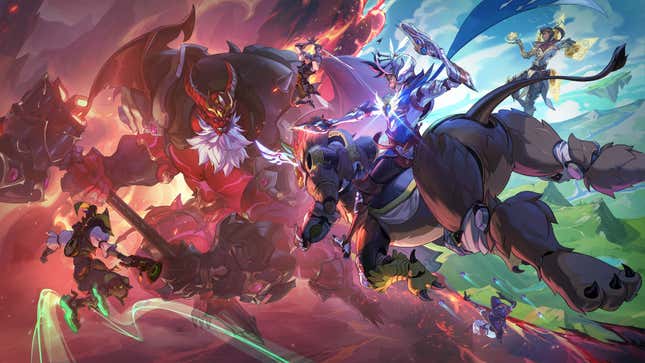
Playing ranked (or competitive) Overwatch 2 is a uniquely difficult experience. Blizzard changed the ranking system when the sequel debuted, removing the numerical skill rating (or SR, a number that ranged from 1 to 5,000), leaving only players’ tier-based ranks (Bronze, Silver, Gold, Platinum, Diamond, and Grandmaster). In the original game, losses meant your number went down, wins meant your number went up, so there was an easy way to keep track of your progress. Removing that number in Overwatch 2 proved frustrating for players who couldn’t fully understand why they were ranked where they were, and Blizzard had to rework how many wins and losses would affect your rank after players complained.
But rank decay and matchmaking ranking (or MMR) made playing competitive even more aggravating this year, as the first dropped players’ ranks each season (and was eventually removed) and the second made it so that your hidden MMR was affected by any match you played—even casual ones, which skewed how you find matches in ranked modes. It’s all very confusing, but Blizzard recently promised that major comp rework is coming sometime next year, so hopefully I can finally claw my way back to Diamond where I belong. — AM

The light at the end of the battle pass is the Mythic Skin. These customizable looks are some of the most elaborate, premium skins Overwatch 2 has in its giant closet, with a new hero getting one each season. There have been some really great ones, including Tracer’s fantasy-based Adventurer skin and Ana’s robotic, haunting Omnic one. But getting to the end of the battle pass and unlocking a Mythic Skin hasn’t felt as sweet during the last few seasons of 2023.
Hanzo and Orisa are the most recent Mythic heroes, and both of them have significantly fewer customization options than previous skins. The battle pass has been a point of contention since Overwatch 2 launched, with some players preferring the original game’s loot boxes that could be unlocked for free. If its rewards aren’t worth the grind, what are they even here for? This isn’t a knock on the design of the skins themselves (although Orisa’s looks nearly identical to a standard skin she’s had for years), but if Blizzard is going to remove what made these skins special, it makes grinding the battle pass a harder sell. — KS

In 2023, Blizzard opened up Overwatch’s world for third-party collaborations. The first was a set of skins and other cosmetics based on the anime/manga One-Punch Man, which naturally turned Overwatch’s own “one-punch man,” Doomfist, into the titular hero with a new skin. The cape is luxurious, but he’s not the only hero who got to cosplay during the event. Soldier: 76 gets to ride a bike as Mumen Rider, Kiriko’s green wig is wigging as the Terrible Tornado, and Overwatch’s resident cyborg Genji naturally becomes One-Punch Man’s cyborg Genos.
Looking back, the collaboration was strange because One Punch Man hasn’t really been doing much as of late, with the third season still in development and the last one having come out in 2019. But there’s a surprising amount of love shown in the skins, highlight intros, and other cosmetics, as silly as it is seeing Soldier: 76 pedaling like his life depends on it.
The second big collaboration was with K-Pop girl group Le Sserafim, and it was an absolute banger of an event. Take my hand, walk with me. Have you heard the good word of Le Sserafim’s catchy as hell bop “Perfect Night”? Have you basked in the glory of Tracer, Kiriko, Brigitte, D.Va, and Sombra geared up for a K-Pop concert, serving some of the most glamorous skins Overwatch has ever seen? And did you watch the music video, in which all the previously mentioned girlies attend a Le Sserafim concert and use their various abilities to have their own perfect night? It ruled. I’m still wearing the Sombra skin when I play her, and have no plans to take it off.
While Blizzard looked outside of its stable for crossovers, it also looked to the other side of the office and had a Diablo crossover, as well. Moira mains rejoiced as she finally got a decent skin out of the arrangement, though the Diablo-themed co-op mode was extremely mid and tiresome. Also, John Cena showed up in a viral marketing campaign for some reason, though that had no impact on the game itself.
Even if you don’t watch One-Punch Man or jive with Le Sserafim’s music, Overwatch 2’s collaborative events have felt meaningful, not like they’re just cheap crossovers. The team at Blizzard has done a lot to capture the vibes of its partners without it coming at the expense of its own identity. Crossovers can be exhausting, as games like Fortnite can lose their entire sense of self as they clutter their worlds with pieces of other properties. But so far, Overwatch 2 has found a happy medium in paying tribute to something within its own framework. — KS

Everybody wants to kiss Overwatch characters. That’s why, even with dwindling player counts, its heroes are still at the top of Pornhub’s video game searches in 2023. Blizzard finally caved and gave our thirsty asses a dating sim called Loverwatch. The visual novel didn’t let you date every hero, but if you’ve got the hots for Mercy or Genji, boy, it was time to go to town. It was playable in browsers from February 13 to 28, and while it isn’t active at the moment, the website implies it will come back. Perhaps next Valentine’s Day, we’ll see Loverwatch return with new routes to explore. Let me kiss Baptiste, Blizzard. — KS
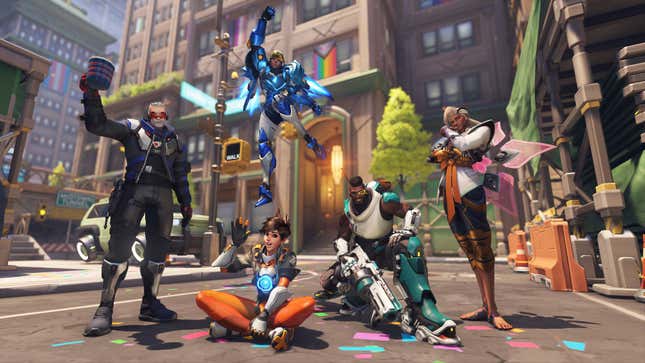
Overwatch’s relationship with queerness has been fraught over the years. It has a diverse cast of characters from around the world, but until recently, their queerness has existed in a place of plausible deniability. Heroes would be confirmed canon gays in external media like comics and short stories, but you didn’t see traces of it in the game itself. Overwatch 2’s first Pride event took place in June, and while it wasn’t perfect, it did give its queer heroes and players ways to express their identity without ambiguity. Lifeweaver was confirmed pansexual when he was announced, and the Pride event included a short story that stated Baptiste is bisexual and Pharah is a lesbian, bringing the queer roster to five alongside Soldier: 76 and Tracer.
The Pride event changed the game’s Midtown map into a copless Pride parade, and gave players cosmetics like Pride flag name cards to express both their own identities and that of the specific heroes. I don’t think I’m ever going to change my name card from the Soldier: 76 gay flag. Hopefully, next year we get more, including a non-binary one for Venture, the next damage hero coming in 2024. — KS
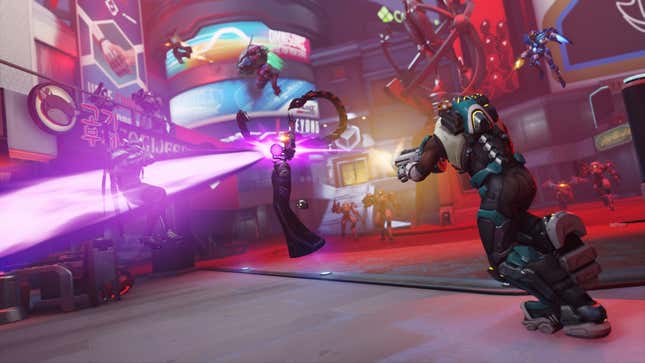
The biggest blunder for Overwatch 2 this year was the gutting of its planned PvE suite. In May, Blizzard hosted a stream in which game director Aaron Keller and executive producer Jared Neuss announced that some of the planned PvE modes (which were first announced in 2019), including replayable hero missions and talent trees that let you customize your character’s abilities, had been canned in favor of focusing on the competitive game. The story missions are still happening and will act as the driving force of the Overwatch plot moving forward, but a lot of the fancy dressings that made them feel like more than just an iteration of the original game’s Archive missions will never see the light of day.
This was a major blow to the narrative Blizzard had been trying to craft about why Overwatch 2 was necessary when the original game was right there, still functional, and lacking content updates in anticipation of a sequel. The initial pitch for Overwatch 2 at Blizzcon 2019 was that it would bring story, cooperative elements, and PvE gameplay as a pillar of the game, all while allowing original Overwatch players to keep playing competitively alongside Overwatch 2 players in a shared multiplayer environment. Some of that has technically come to fruition, since nobody had to buy a second game to keep playing. But what has changed is the business model, how much money you have to pay to take part in things that used to be free, and how many players are on each team.
The loss of those PvE modes is both a loss for the game, as well as a reminder that Overwatch 2 is not what Blizzard said it was going to be when it was announced in 2019.— KS
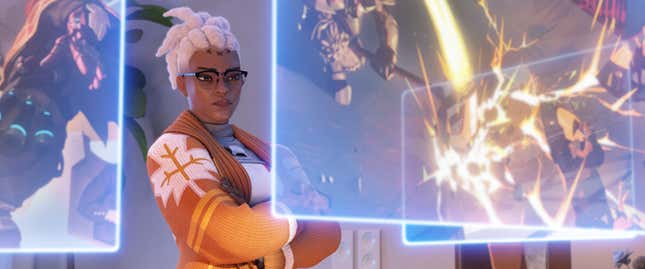
But what about those story missions? Overwatch 2 took almost a full year to release its first set of Invasion PvE levels, and they were mostly ones we’ve already seen in the four years since they were announced. Honestly, as much as they now feel like echoes of a game that we’ll never get, they are pretty good. Blizzard has included enemy and mission variety that makes Overwatch 2’s story missions a cut above the cooperative Archives events from the original game, and there’s a lot of legitimate narrative momentum to be found in each.
As a longtime fan of the world and heroes of Overwatch, I was really happy with what we got. There are some great interactions between heroes during firefights, and the heartfelt stories they tell fill out complex relationships that were previously boiled down to pre-match quips. Is that worth $15 a set, which you’ll have to shell out for each new story mode mission release going forward? I can’t answer that for you. I don’t know your financial situation. But for what they were, I was satisfied and would still be satisfied with more missions of this caliber.
Therein lies the issue, though. We don’t know when the next story missions are coming. During Blizzard’s Overwatch 2 presentation at Blizzcon 2023, there was a lot of talk of new heroes and modes, but not a word was said about the next wave of story missions. Does that mean they’re not coming in 2024? It’s unclear, but we’ll have to wait to find out. — KS

I don’t know how Blizzard hasn’t released a full Overwatch animated series at this point. The company has put out some banger animated work this year in the form of the Genesis anime and the Mauga introductory short.
Each time Blizzard gives us small glimpses into what an Overwatch animated series would look like I get frustrated because it should have existed years ago. It’s funny, but I spend so much time complaining about how we’ve been longing for more Overwatch story that I forget just how good it is when we finally get some. While the Genesis anime was a great worldbuilding piece and the Mauga short gave us an explosive introduction to the new hero, it all just feels like teases for something that could be huge if Blizzard would arrive at a deal to make it happen. Give us an Overwatch Netflix series, y’all. — KS
The Overwatch League (OWL) was Blizzard’s attempt at building a massive esports league on a franchise-based model like the NFL. It was an expensive endeavor, one the soon-to-be-gone-CEO Bobby Kotick championed, and for a few years, it was pretty damn successful. But the swap to Overwatch 2, the cost of the league (a $20 million buy-in that Sports Business Journal reports dropped to $10 million, though it’s unclear when), and brand partners reportedly hesitant to keep doling out funds amidst allegations of sexual harassment taking place within Blizzard, all saw the league struggle in the last few years.
This year, the OWL officially died, and though Blizzard maintains it’s still committed to fostering a rich esports environment, the Grand Finals were a depressing (but beautiful) send-off to a once-beloved league. Who knows if we’ll get an Overwatch esports league in 2024? If we do, it certainly won’t be like the OWL. — AM
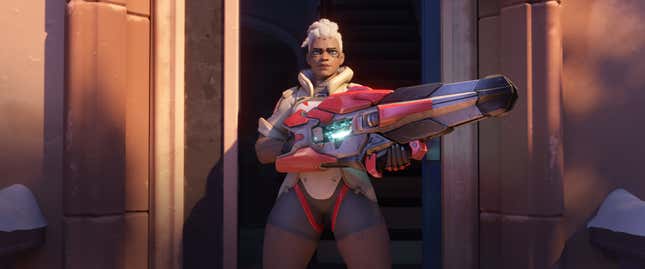
So what is the state of Overwatch 2 now? It’s certainly not what Blizzard pitched in 2019. But is it really an absolute disaster dumpster fire that nobody should play? No, honestly. When Overwatch 2 shines, it is an immaculately designed hero shooter with more character and heart than most games in its genre can claim.
Overwatch 2 crash-landed when it could have soared above its contemporaries, and a lot of its 2023 has felt like an attempt to right the ship.The sequel has a more focused and stable foundation than it did at the start of this year, but there’s still more than enough reason for anyone to be skeptical.
When this game was announced in 2019, it seemed like everything I wanted out of Blizzard’s hero shooter was finally happening, and 2023 has pretty much solidified that I’ll probably never get a game that lives up to those lofty expectations. And yet, it was easily the game I played the most in 2023, and after writing all this, I want to boot it up right now. Maybe it’s compulsion at this point. Perhaps I’ve become so accustomed to queuing up and pushing payloads that I don’t know any other way. But if I’m still coming back, there must be something in this world worth fighting for. — KS
